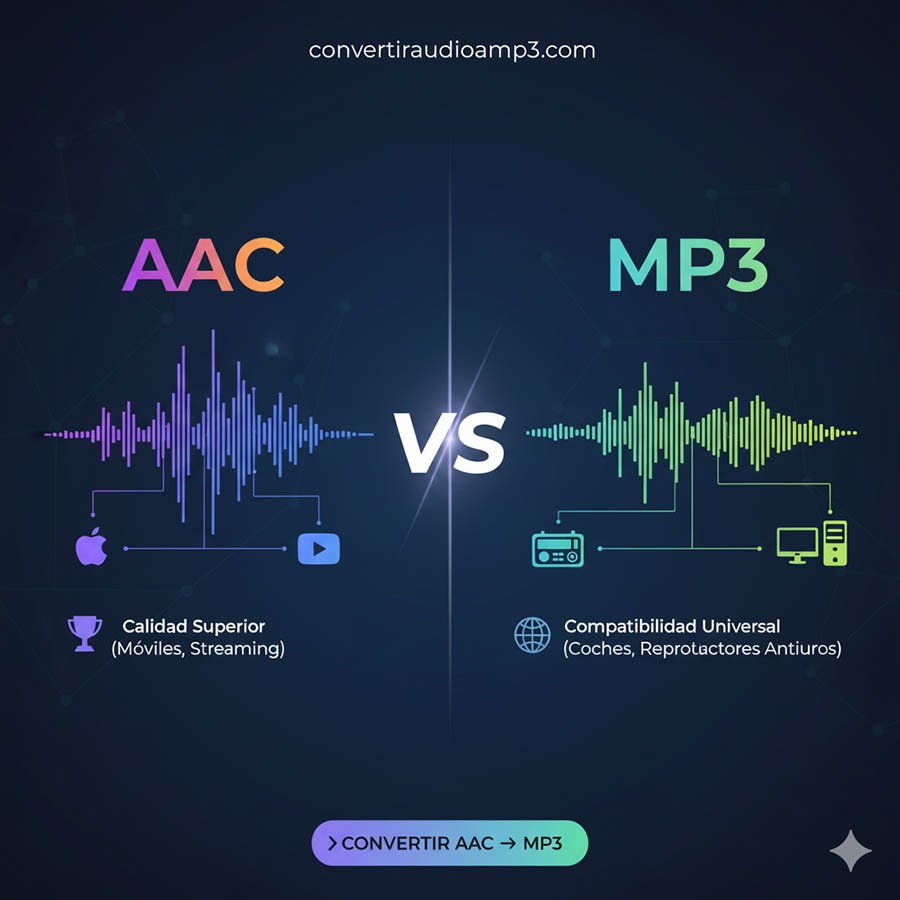AAC vs. MP3: Which audio format is best for your music?
In the world of digital audio, MP3 has reigned supreme for decades. But in the era of streaming and mobile devices, a quiet contender has gained ground: AAC (Advanced Audio Coding). Used by giants like Apple, YouTube, and Spotify, AAC has become a high-efficiency standard.
So how different is it from MP3? Which sounds better? And, most importantly, which should you use? In this article, we break down the essentials so you can choose the right format for your music collection.
✨ Got an AAC file you need to convert?
Convert AAC → MP3 (free & online)100% online • Works on any device
What is the AAC format?
AAC isn’t new—it was created to solve the same problem as MP3: compress audio without sacrificing too much quality. Its more modern design uses a more advanced compression algorithm. The result: for the same file size, AAC typically delivers noticeably better sound than MP3.
Key advantages of AAC:
- Higher efficiency: More sophisticated compression often means better quality at the same bitrate. For example, a 128 kbps AAC can rival a 192 kbps MP3.
- Better quality at mid bitrates: Especially around 96–160 kbps, AAC usually outperforms MP3 in fidelity.
- Modern support: It’s the default for iTunes/Apple Music; YouTube uses it for video audio; services like Spotify and various devices also support it.
Why MP3 is still relevant
Despite AAC’s technical advantages, MP3 remains essential for one simple reason: universal compatibility.
- Compatibility: From legacy MP3 players and car stereos to TVs and consoles, almost everything can play MP3.
- Familiarity and adoption: It’s the most widely used audio format online—easy to share, easy to manage.
Comparison table: AAC vs. MP3 (with your MP3 bitrates)
Here’s a quick head-to-head, focusing on common bitrates and the MP3 options we offer:
| Feature | AAC | MP3 (64k, 128k, 192k) |
|---|---|---|
| Efficiency (quality/size) | Higher—more detail at lower bitrates. | Good—industry standard. |
| Sound quality | Generally better than MP3 at the same bitrate. A 128k AAC can sound like a 192k MP3. |
|
| Compatibility | Limited to modern devices/software (Apple, YouTube, etc.). | Universal. Plays almost everywhere. |
| Common use | Streaming (Apple Music, YouTube, Spotify), Apple devices. | Music libraries, car stereos/USB sticks, broad sharing, web radio. |
When to use AAC vs. MP3
- Pick AAC if… quality and efficiency are your priority and playback will be in a modern ecosystem (Apple devices, capable media players on PC/Android, or streaming).
- Pick MP3 if… you need universal compatibility. It’s the safest choice for car USB sticks, sharing files without worrying about the recipient’s device, or working with older audio software. At 128k or 192k, music quality is excellent.
The practical fix: Convert AAC to MP3
Even though AAC is technically stronger in many scenarios, it’s not as broadly supported as MP3. If an AAC won’t play in your car, on a standalone MP3 player, or in a certain editor, the simplest solution is to convert it.
When converting AAC to MP3, choose the bitrate you need—64k for voice, 128k for standard music, or 192k for higher quality—and your audio will work on virtually any device or app, with no perceptible loss for most listeners.
Fast • Free • Online
